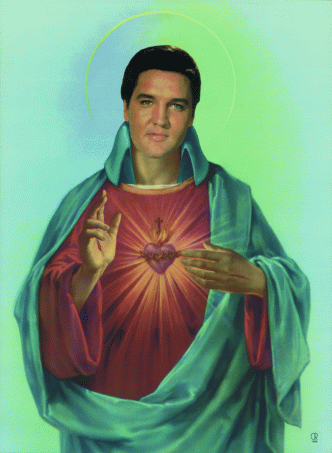An article by our very own Frater Isla. Originally published October 31, 2013 via theblogofbaphomet.com
Most
folk’ll tell you the use of pop culture iconography in ritual began in
the 80′s with Chaos Magick and the IOT. A few folk’ll tell you it
started earlier with people like William S. Burroughs, who was known to
use a cardboard stand-up of Mick Jagger for “rites of performance.” But I
think it can be traced back to the beginning if you consider that at
one time, even the Sumerian gods were pop sensations.
Recently, though, a trend has popped up that I’ve found myself right in the middle of: serious religious devotion given to fictional characters drawn from pop culture. I’m a member of the Sons of the Batman, a magical group that honors the Caped Crusader. Although it may appear to be a joke or an intellectual exercise, it’s definitely not, and we take the worship of Batman very seriously.
And we are by no means the only ones.
Probably the most successful religious group inspired by a fictional source (outside of Scientology) would have to be the Church of Jediism. The Jedis have even gained tax-exemption in the US as a recognized non-profit religious organization. Their religion draws from the fictional universe of Star Wars, but they do not recognize its stories as any sort of scriptural reference. Instead, they see it as a point of philosophical inspiration, from which they’ve drawn the “16 teachings” and “21 Maxims.” They definitely believe in the Force, though.
Jediism gained attention during the 2001 New Zealand census, after an e-mail campaign inspired more than 53,000 to list “Jedi” as their religion. In the England and Wales census that year, over 390,000 claimed the same. The figure dropped to 176,000 last year, still outnumbering all the other “alternative” religions (including Atheism, numbering 29,000).
In 2004, Matrixism announced its arrival. It considered the Matrix films and related media to be a “sacred text,” which are said to be inspired metaphors of an idea articulated by `Abdu’l-Bahá’, son of Bahá’u’lláh, founder of the Bahá’í faith. According to its website, there are over two thousand adherents to the “Path of the One.”
There’s also a Church of Elvis, a Church of all Worlds (based on the fictional religion from Robert Heinlein’s Stranger in a Strange Land), and even the first rumblings of a cult dedicated to My Little Pony. I’m sure with more digging, one could find many more examples.
Jediism and Matrixism were studied by Dr. Adam Possamai, along with other pop-inspired religions that he termed, “hyper-real spiritualities.” Possamai believes that these groups are the product of what he calls a “McDonaldised Occult culture,” in which the beliefs that were once kept secret by groups like the Golden Dawn or the OTO are now easily found on the internet and bookshelves everywhere, making open comparison an easy task. Compound this with a desire to synthesize a consumerist culture with the search for a spiritual path, and you’ll have some seekers finding a parallel between the religious teachings of more traditional sources and the themes found in fiction.
My own entrance to these ranks came about when I had the epiphany that my own beliefs were influenced not by Christ, Mohammed, Krishna, or Pan, but by the stories of the Batman. Without knowing it, by immersing myself within the Batman myth since the age of three, I was allowing it to mold my thinking as my ego and sense of morality formed. By acknowledging and actively reinforcing this belief structure, I began to experience a real clarity in my personal spiritual practices and the strange sense that I had possibly stumbled onto a kind of magical lynchpin. After years of experimenting with the deities of a variety of cultures, the myth that seemed to inspire me the most was the one I had so happily consumed since childhood, never imagining it to be divine in any way.
The switch from viewing these pop culture icons as mere tools to use in the practice of results magic to objects of spiritual devotion seems to coincide with a general trend. It appears that the prevailing themes of cynicism and irony which defined the attitude of occultism in the 90′s has been replaced with a hunger for sincerity. Unlike their predecessors, the modern youth culture is unabashed by its reliance on consumerism and seems willing to integrate it into their spiritual life.
It’s possible that rather than just being an interesting blip in religious evolution, devotion to the icons of pop culture may very well be the next serious movement in magic.






